
So you are interested in photography? Maybe you have been taking photos of your children or friends and family? Or maybe you haven’t even bought your first camera yet. Well I am here to tell you that if you are willing to put in the work, you can absolutely be a photographer!
I am a completely self-taught photographer. I never attended any formal photography schools, classes or even workshops. I never had a mentor or teacher even though I might have liked to have had one. So I read books, watched videos, and practiced, practiced, and practiced some more.
I didn’t have a lot of time either. I was raising my first child and then had three more along the way. I didn’t have a mother (aunt, sister, friend, or anyone close by) to help me watch my children while I learned. I worked on my photography late at night after putting my kids to bed.
I’m not telling you this to toot my own horn, I’m telling you this because if I can do it, then you can do it too. I am no different…I’m just a regular person. Honestly, technical things, like cameras, make my head hurt. But after spending hours learning how to operate every single button on my camera, holding it in my hand has become second nature. I don’t even think about all that “technical” stuff anymore. The camera is just an extension of me now. And one day it will be for you too!
Learning how to operate your camera can be intimidating. There are so many buttons! When you flip a dial one way everything is completely dark and then you turn it the other way everything is white. Don’t worry…we have all been there! All it takes is practice, practice, practice. I still need to practice. If I am busy and I don’t shoot for a while then I am a little rusty the next time I bring out my camera. And it takes me a little practice to get back in the flow of shooting.
Please be aware that this blog post may contain affiliate links. I may earn a small commission (at no extra cost to you, I promise!) to help me keep this blog running if you use these links to make a purchase. Please note that I only recommend tools that I personally use and love and I always have my readers’ best interest at heart.
LEARN HOW TO OPERATE YOUR CAMERA
When I first started learning photography there wasn’t the plethora of information available on the internet that there is today. This was before Youtube was so popular. So you are already one step ahead of me!
The first camera I ever had was a simple Nikon DSLR (I had the Nikon D40 which they don’t make anymore, but you can find used at a very good price). I had no idea how to use it, so I bought the book Nikon D40 for Dummies, and I literally read through it page by page learning how to use each button on my camera. Then I watched videos of people explaining all of the buttons on the camera. I suggest that you make this your first step. If you don’t know what your camera is capable of or how to operate it, then you are limiting yourself from the beginning.
I know that learning how all the buttons on your camera function is not the most exciting part of learning photography. You would rather be out there shooting! But once you know how your camera fully functions, it will give you a huge sense of confidence. The fact that you actually know how to operate this amazing piece of equipment is empowering. I literally go through this process every time I purchase a new camera or piece of equipment.
BEGIN WORKING IN AUTO MODE
OK, so once you have a pretty good idea of what all the flashy buttons and dials on your camera do, it’s time to get out there and take some pictures. When you are first starting out, shooting in auto is your friend. Eventually, you are going to want to learn how to shoot in manual mode. Because it truly allows you to take your creativity to the next level and express yourself in ways auto mode simply will not allow you to do. I know manual can seem scary, but once you figure it out it becomes second nature.
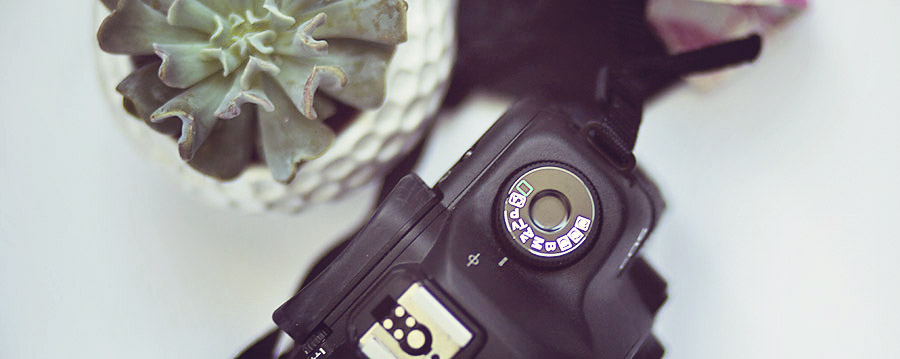
But for now auto is going to give you the opportunity to practice your shooting skills. The main areas I suggest beginner photographers tackle first are focus, composition, perspective, and lighting. Once you have a solid foundation in these areas you are going to see a drastic improvement in your photography.
FOCUS
Perfecting your focus skills is essential. If the main subject of your photograph is out of focus then you don’t have a very strong image (there are artistic exceptions to this rule). It is perfectly fine, in fact sometimes essential, to have parts of an image out of focus. But for now, you never want your main subject out of focus.
Let me give you an example. If you are shooting an image of a little girl in a field, you may choose to have the background out of focus (blurry) and only focus on the little girl. This brings the viewers eye directly to your main subject, the little girl.
Our eyes are trained to immediately look at the part of the image that is in focus. Then the eye wanders to the parts of the image less in focus. If everything is in focus, it is harder for the eye to discern the main subject of the image. The same goes for if everything is blurry. The eye doesn’t know what you want it to focus on.
If you decide that the little girl is the main subject of your image, then you want to make sure she is the primary focal point. But, if you decide that you want the main subject of your image to be the flowers in her hand, then it is perfectly acceptable that the little girl not be in focus. Achieving crystal clear focus can be difficult, but it is a skill you can begin to hone in auto mode.
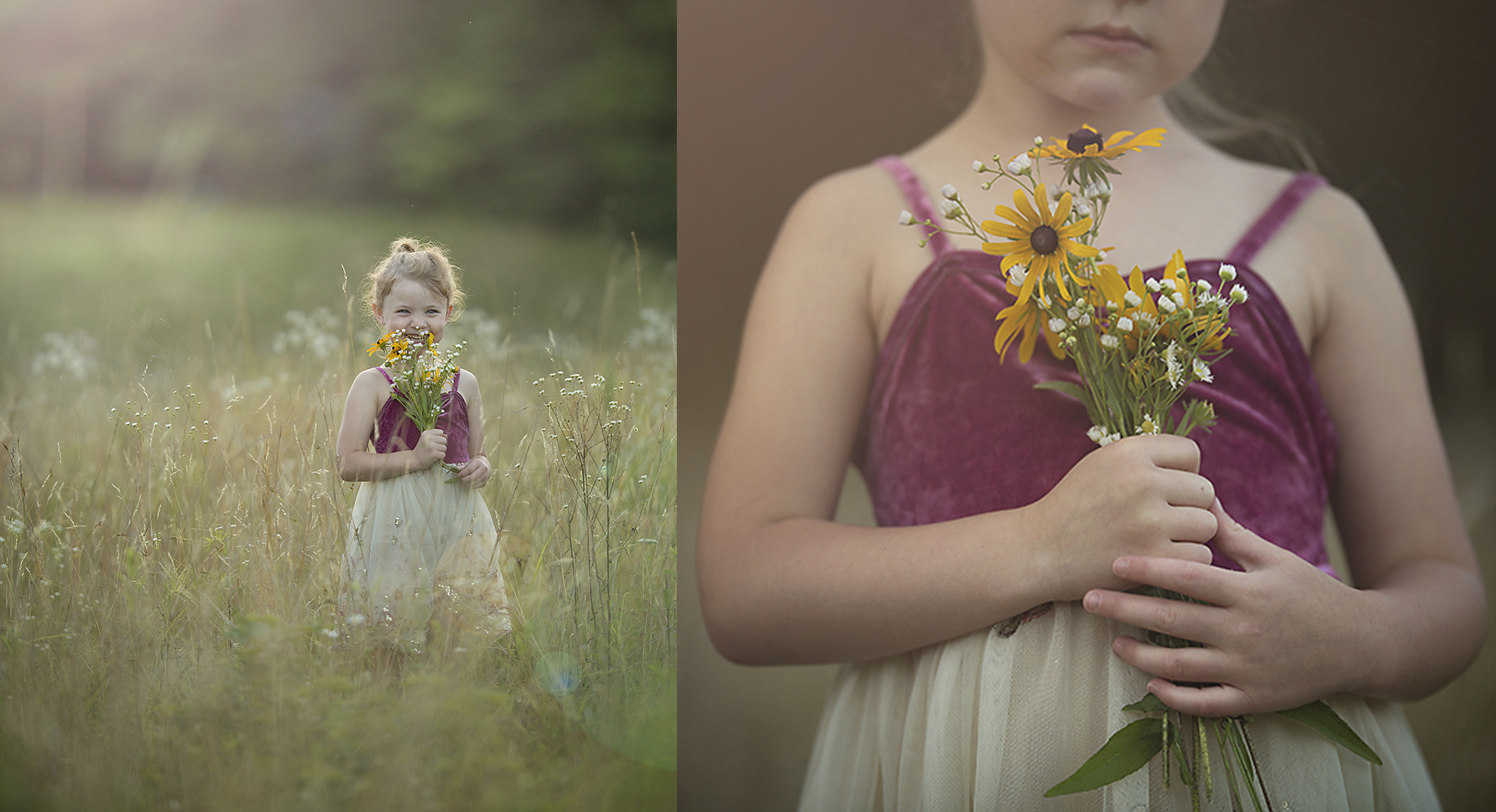
In the image to the left, the little girl is the main focal point. In the image to the right, the flowers in her hands are the main focal point.
If you look at my photos, I like to blur out the background in many of my images because I feel like it really helps to bring your focus to the main subject of the image. That is how I like to create MY images, but you may decide that you like to create your images very differently.
COMPOSITION
Composition is simply how you decide to compose, or frame your image. Do you want your subject in the very middle of your image? Do you think it looks better if the subject is a little to the left? I am breaking this down into very simple terms. There is an abundance of literature about the different “Rules” of photography composition. I could do a single blog post on composition alone, but for the sake of this post, I am just touching the tip of the iceberg. My point is that you can very easily begin to practice composition in auto mode.
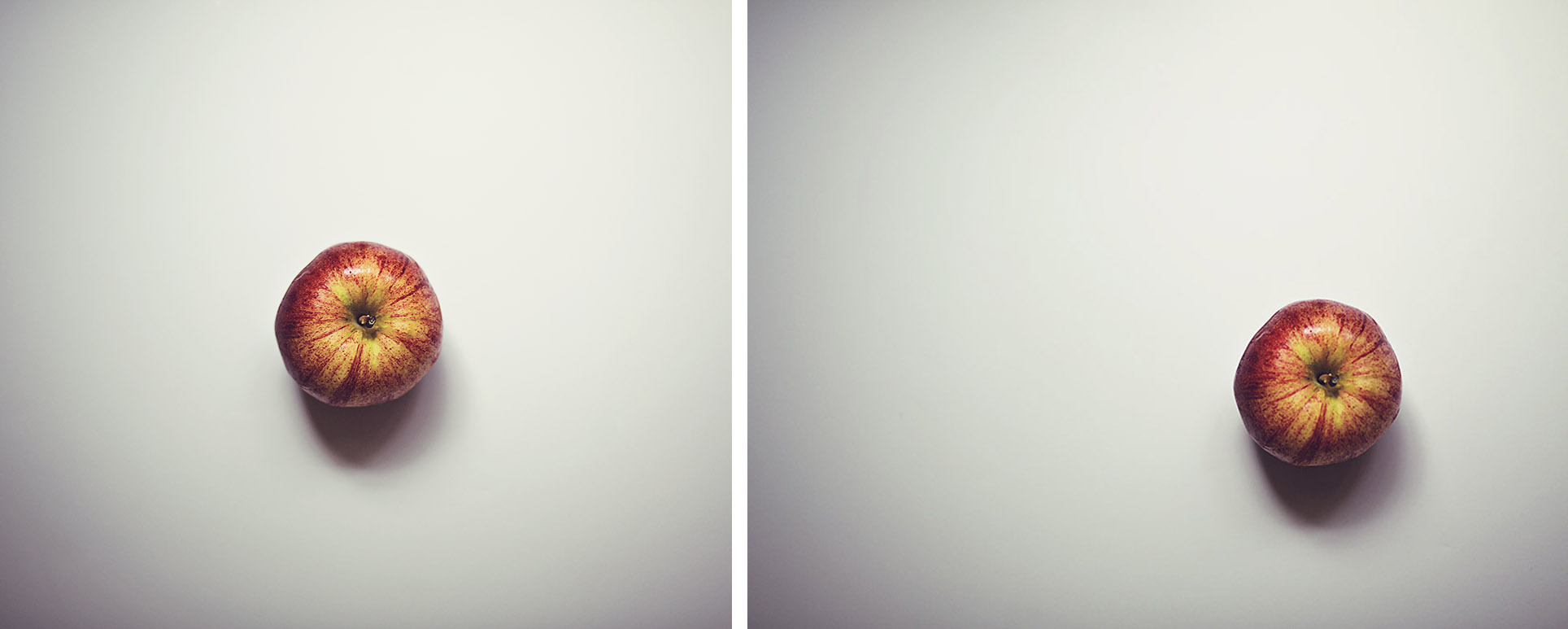
In the image to the left, the apple is framed in the center of the photograph. In the image to the right the apple is placed to the side. It is in the right third of the photograph. This is an example of the “Rule of Thirds.”
PERSPECTIVE
Perspective ties in very closely with composition. And it is something that you can easily begin to practice in auto mode. In simple terms, perspective has to do with the angle at which you shoot your photograph.
Don’t ever feel confined…there are an unlimited number of ways to shoot the same subject. It is easy to come up with very different photographs of the same subject. For example, if you get down low to the ground, the angle at which you shoot your subject will be completely different than if you were shooting from up high on a ladder. This alone will completely change the look, or perspective, of your photograph.
Are you looking down on your subject from above? Are you laying on the ground shooting up at your subject? The perspective, or angle, from which you shoot will have an immense affect on the outcome of your photograph.
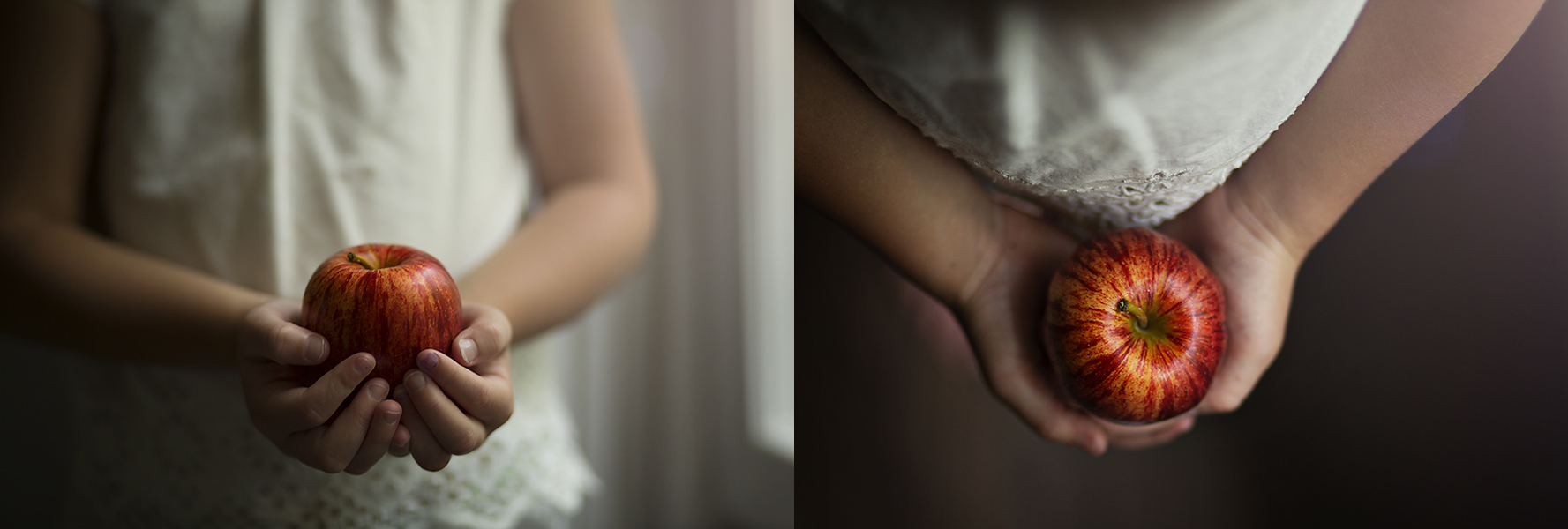
These are two images of the same apple taken from two very different perspectives. In this example, you can see how the change in perspective make a huge difference in the final image.
I like to shoot my images from many different perspectives. I am constantly moving around my subject until I find the perfect angle. Photography is all about seeing the everyday world around us in a different way. Most of us see everything at eye level. But if you can shoot the same thing we see every day from a different perspective, it becomes new and fresh and exciting. It becomes something we have never seen before. Good photography turns the ordinary into the extraordinary.
LIGHTING
Lighting is probably the most important factor in making good images. Photography is all about learning to capture light. Without an understanding of how light works you will not be able to take your images to the next level. This is where you are going to start finding limitations when working in auto mode and you will know you are ready to progress to conquering manual mode. But you can most certainly start your exploration of light in auto mode.
There are three aspects of light that you can begin to study in auto mode.
- Direction of light – Where is the light coming from? Is it high in the sky, shining directly down on your subject? Is it early morning light slanting in sideways from the window. Is it the last rays of light from a sunset. Begin to look at where the light is coming from and how it affects your image.
- Quality of light – Is your light harsh or soft? A bright harsh light is going to cast strong shadows while a soft light is going to create softer ones. Depending on what you are trying to achieve in your image the quality of your light is going to make a huge difference.
- Color of the light – The color of your light sets the tone or mood of your image. Are you shooting the warm glow of a sunset or the cool mist of a morning sunrise? The warmth or coolness of your light is going to have a major affect on the skin tones and the tones of any colors in your image. Have you ever tried to take a portrait of someone sitting in green grass, only to find that their skin seems to become a strange yellow/green color? This is the light reflecting off of all that green grass and bouncing onto your subject.
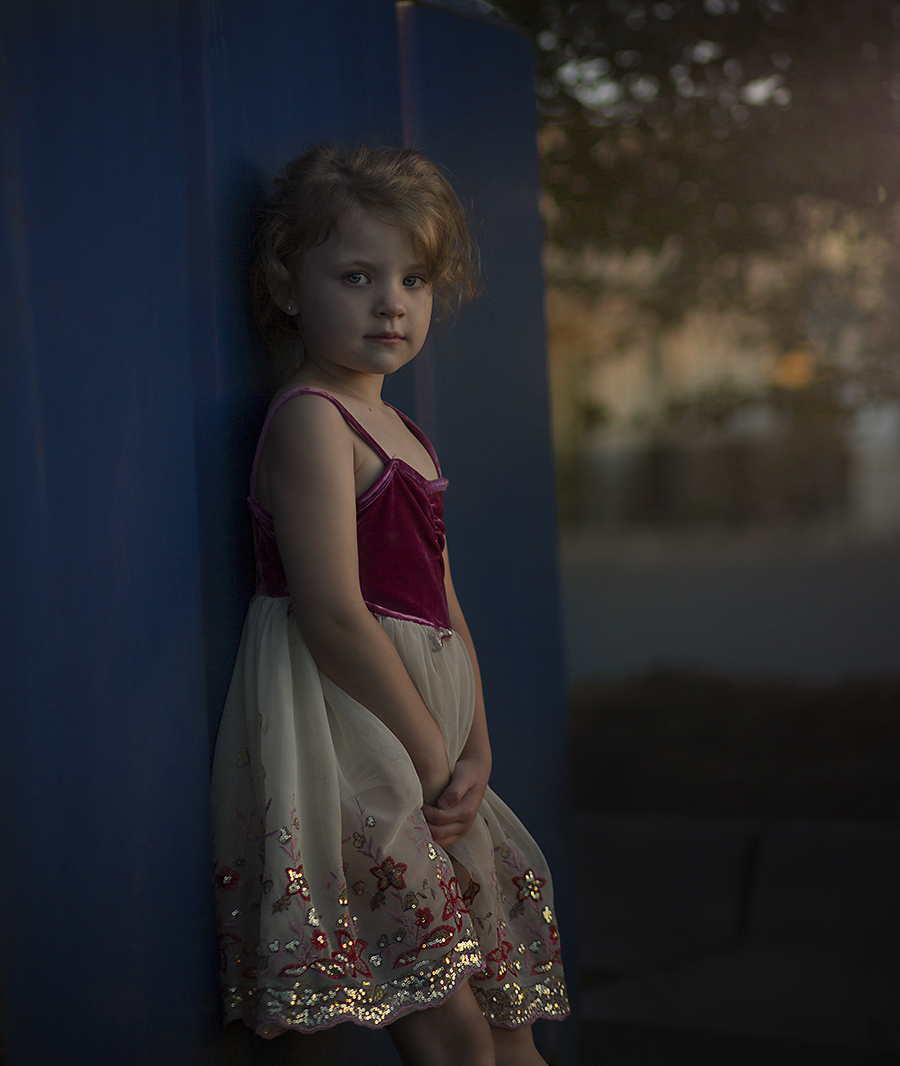
This image was taken at sunset. The light is coming from the right. The sun is setting so the shadows are very soft and the colors cast a warm golden tone over the image.
Once you have a foundational understanding of light you will really begin to start making images that look more professional and be on your way to bettering your photography.
LEARN FROM OTHER PHOTOGRAPHERS
Try to find other photographers that you admire. If you like how their images look, it can be a helpful exercise to try to recreate the qualities of their images that you admire. I found that there were certain aspects of other photographer’s work that I thought were amazing. So I set out to recreate those particular qualities in my own images. For example, as I mentioned earlier, I love blurring the background in my images and I set out to learn how to do that like the photographers I respected.
Now, if you decide to attempt this exercise, then may I suggest some guidelines here. If you want to make an exact copy of another photographers work that is fine for the sake of practice. I think that there is a lot of value in it because you learn what to do and what not to do to create an image. But, I would not recommend that you then share that photograph and claim it as your own original work.
Most everything has already been done before, so it is ok to look at other artist’s work for inspiration. If there is an aspect of another artists’ work that inspires you or sparks an idea for you to then go make your own creation, then go for it. Perhaps you love how an artist works with certain angles and you want to take that and create your own own photos with a similar angle. Then do it and learn as much as you can. Just please don’t make a copy of another artists’ work and claim it as your own. It takes away from all the hard work that artist went through to create his or her own art.
EQUIPMENT
I want you to know that you do not need to invest in the most expensive camera or lenses when you are first starting out. Do not tell yourself that if only you had a better camera that you could take better photographs. A good photographer can take good photographs with a very simple setup. Even a camera phone! I am telling you this to encourage you. Photography equipment can be very, very expensive. If you are taking good images, but find that your current gear is limiting you, then it might be time to upgrade. Don’t get lost in the idea that if only you had this lens or that camera that you photographs will finally be good. Because it’s not the camera, it’s the person behind it.
FINAL THOUGHTS
If you can incorporate these photography basics into your current repertoire you will be well on your way to building a solid foundation of photography skills.
- Learn how to use your camera
- Start in auto mode
- Focus
- Composition
- Perspective
- Lighting
- Learn from other photographers
- Start with simple equipment
You are going to shoot bad photographs. We all do. If I shoot a session, I end up throwing away probably half of the photographs. It takes a lot of work to get everything to line up correctly for a great shot. But you are never going to get anywhere if you don’t practice, practice, practice.
During this process you will start to learn what kind of images YOU like best and this is the beginning of discovering your own personal style of photography! These are the kinds of things you need to play around with when working in auto. Get comfortable with shooting at different angles and play around with focus so that you can build a solid foundation of the basics of photography. Good luck!
XO, Ruth
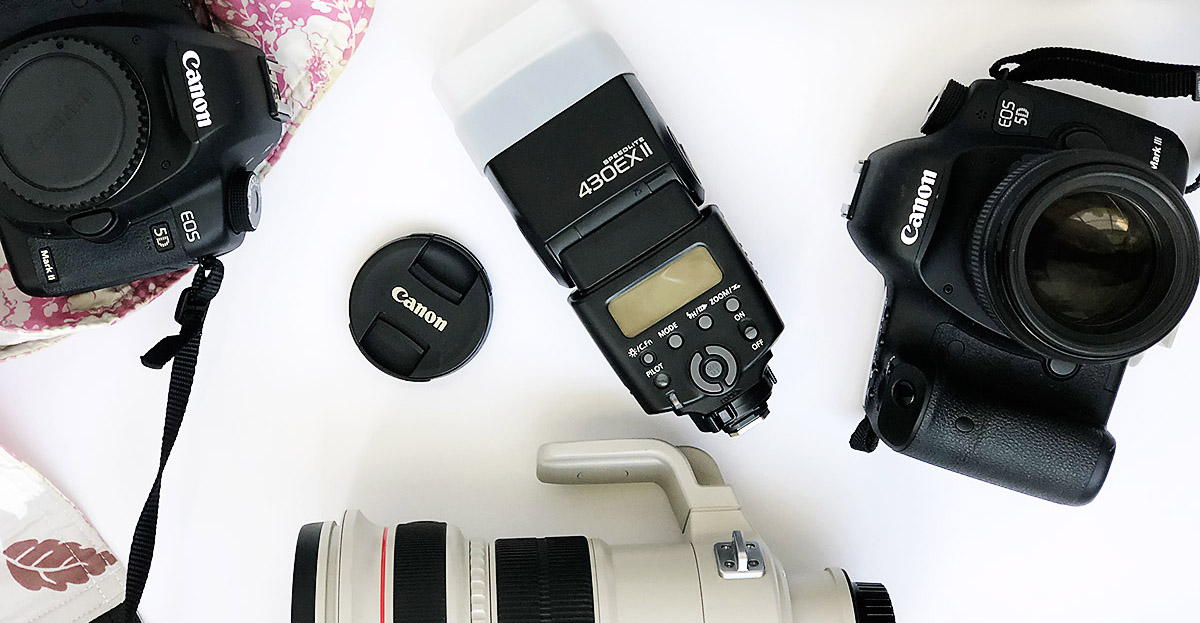
Be the first to comment